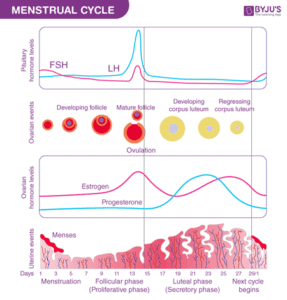The menstrual cycle is a remarkable and intricate process that occurs within a woman’s body. It is a natural occurrence that allows for the possibility of pregnancy and signifies a woman’s reproductive health. Despite its significance, the menstrual cycle has often been shrouded in mystery and taboos. In this blog post, we aim to shed light on this topic and empower women by providing a comprehensive understanding of their menstrual cycle.
Understanding the Menstrual Cycle
The menstrual cycle is a recurring series of physiological changes that a woman’s body goes through in preparation for pregnancy. It typically lasts around 28 days, but can vary from woman to woman. The cycle is orchestrated by the complex interplay of hormones, primarily estrogen and progesterone, and involves several phases:
Menstruation: The cycle begins with menstruation, often referred to as “the period”, the shedding of the uterine lining. This phase lasts for about 3-7 days, and women may experience varying levels of discomfort or pain, known as dysmenorrhea.
Follicular Phase: After menstruation, the follicular phase begins. During this phase, the pituitary gland releases follicle-stimulating hormone (FSH), which stimulates the ovaries to develop several follicles. One follicle will eventually become dominant and mature, while the others will regress.
Ovulation: The mature follicle releases an egg during ovulation, usually around the 14th day of the cycle. This is the most fertile period for women, as the egg can be fertilized by sperm and lead to pregnancy.
Luteal Phase: After ovulation, the ruptured follicle transforms into the corpus luteum, which produces progesterone. This hormone helps prepare the uterine lining for implantation. If fertilization does not occur, the corpus luteum degenerates, hormone levels drop, and the next menstrual cycle begins. The physical and emotional changes that happen during this phase are referred to as premenstrual syndrome (PMS).
Understanding Menstrual Irregularities
A woman’s menstrual cycle may not always follow a perfect 28-day pattern. Being aware of common irregularities such as longer or shorter cycles, irregular bleeding, and conditions like polycystic ovary syndrome (PCOS) and endometriosis will help woman recognize the irregular signs, seek medical advice, and maintain a healthy lifestyle that contributes to her overall well-being.
Menstrual Cycle and Fertility Awareness
Understanding the menstrual cycle can empower women to make informed decisions about their reproductive health and family planning. Fertility awareness methods (FAM) enable women to track their menstrual cycles, identify fertile periods, and use this knowledge to either achieve or avoid pregnancy.
FAM techniques include tracking menstrual flow, monitoring basal body temperature, observing changes in cervical mucus consistency, and using ovulation predictor kits. These methods can also provide insights into hormonal imbalances or irregularities that may warrant medical attention.
 (Image courtesy of https://byjus.com/biology/menstrual-cycle/)
(Image courtesy of https://byjus.com/biology/menstrual-cycle/)
Understanding and embracing a woman’s menstrual cycle is crucial for her overall well-being, reproductive health, and empowerment. By educating ourselves and others about this natural process, we can break the barriers of stigma and ignorance surrounding menstruation. Let us celebrate the incredible strength and resilience of women and work together towards a world where menstruation is seen as a normal and respected part of life.
Here at Advice & Aid, we care about every aspect of a woman’s body. We are truly here to offer care for your health. If you want to speak to one of our nurses about what’s going on with your body – whether that is periods, pregnancy or post-abortion care – it’s as simple as clicking the button and scheduling your free appointment. We’re here for you.

